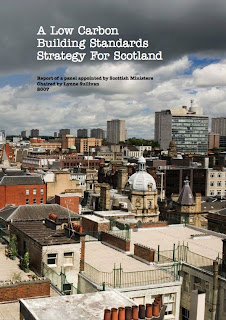Social housing boss, Sir Bob Kerslake, signalled a retreat from the government’s 3 million new homes by 2020 target, as reported in Building today. No surprises there, you may think, as housebuilding has been hit for six by the economic downturn and it looks as though completions this year will be at their lowest for a long long time, just at the point in time when they should be powering ahead — if those targets were ever to be met.
What caught my interest that about this story was not so much that the targets were under review but that Kerslake gave a new reason for the existence of the targets in the first place.
He said that it was still vital that the government hit its housebuilding targets in order to prevent the growth of a society of haves and have nots.
Up until now, the justification has always been that there is a terrible housing shortage and that young people can’t afford to get on the housing ladder. Now that justification is beginning to look rather thin: if there was such a terrible shortage of housing, why would prices be falling?
Now the reasoning seems to have changed to one that sounds more like a method of wealth redistribution. But this is still assuming that home ownership remains a means of becoming wealthy, which is what Thatcher originally espoused all those years ago. If the credit crunch is telling us anything, it’s telling us that the old ways of thinking about home ownership, and in particular the gearing effect of mortgaging yourself to the hilt in order to get rich, are kaput. It’s now rather more likely that, once the dust has settled and house prices have found a floor, we’ll experience many years of what Germany has been seeing ever since reunification – stable house prices. More particularly, the land may hold its value but the house itself becomes a depreciating asset, rather like a car. In which case, the gap between the haves and the have-nots may not be quite as far apart as Kerslake suggests. And the rationale behind building 3m new homes looks even weaker.
The online ramblings of Housebuilder's Bible author Mark Brinkley. The paper version is updated every two years and is widely available via UK bookstores and Amazon
30 May 2008
29 May 2008
Varilight: Handle with Care
Now maybe I am a big strong ham-fisted bloke (I am) who is naturally a little clumsy (I am), but this has never happened to me with a lightbulb of any description before. Maybe the Varilight isn’t quite as robust as you might hope for.
I looked at the packet, which says that the bulbs last 16,000 hours and gave a wry smile. I briefly worried about mercury contamination. Figuring life was short enough already, I then cleared up the mess and put another Varilight in its place, this time handling it a little more gingerly. Thus far, a week later, everything is working fine.
15 May 2008
Varilight Dimmable CF Bulbs
 My youngest son, Guy, is just doing his GCSEs. He’s got a geography teacher who “is always batting on” about energy saving lightbulbs, chivvying her class to get their parents to fit them everywhere. It’s the sort of topic that doesn’t really excite teenage boys, as you can imagine. They get a lot of chivvying these days. Don’t drink, don’t smoke, don’t take drugs, don’t mug anyone: energy saving bulbs fit into that sort of category. No wonder they are all playing GTA4.
My youngest son, Guy, is just doing his GCSEs. He’s got a geography teacher who “is always batting on” about energy saving lightbulbs, chivvying her class to get their parents to fit them everywhere. It’s the sort of topic that doesn’t really excite teenage boys, as you can imagine. They get a lot of chivvying these days. Don’t drink, don’t smoke, don’t take drugs, don’t mug anyone: energy saving bulbs fit into that sort of category. No wonder they are all playing GTA4. But last night I showed my sons the Varilight and lo and behold they were impressed. “Now that is cool,” said eldest, Jack. I was impressed that he was impressed. We were all impressed.
You see, the Varilight is a dimmable compact fluorescent, the first that I have seen. By flicking the switch off and on quickly, the bulb comes on full brightness and then after a second or two starts to dim. In fact it goes into a mode where it cycles between full output and around 20% output. If you leave it like this, it carries on changing output indefinitely — this is the feature that the boys found “cool.” When you get to the output you desire, you flick the switch off and on again, and the lamp comes back on at that level and will continue to do so everytime you switch it on again in future, or until you put it back into cycle mode once more. It’s all down to a quick off/on on the switch, a bit like a double click on a mouse. It’s a lightbulb for the wired generation.
What’s more, it’s a really good quality light, much warmer than your typical CF bulb, and it’s only slightly larger than a conventional bulb. I’m sold. Made by Doyle & Tratt in Horsham, Sussex, and available online for around £10, it strikes me that Varilight would make an ideal late-Noughties gift. I imagine in two or three years, dimmable CF bulbs will be two-a-penny, but right now they have cachet.
One word of caution. Varilight make a version of this lamp that is designed to work with dimmer switches, as well as having both formats available in bayonet or screw-fit. You have to read the website quite carefully so as you are sure which one you are buying. The one I have been testing is known as the YCA20S-B22 - Varilight Switch Dimmable energy saving lamp, Compact Fluorescent Lamp, with Bayonet Fitting, whereas the Dimmer Dimmable ones are known as the YCA20D-B22 - Varilight The NEW Varilight Dimmer Dimmable Energy Saving Lamp with Bayonet Fitting. Not exactly user friendly, is it? And the website isn’t the most elegantly designed beast you will ever come across either, so you may end up feeling that you are not quite sure what it is you are buying.
13 May 2008
On the Sullivan Report
 I am really impressed by the Sullivan Report. Living in England, I’d not heard of it before today because it refers to Scotland. But as I’m lecturing in Glasgow this weekend, I have been mugging up on what lies in store for the Scots on the road to zero carbon, aware that the remit of the Code for Sustainable Homes (CSH) doesn’t spread north of the border.
I am really impressed by the Sullivan Report. Living in England, I’d not heard of it before today because it refers to Scotland. But as I’m lecturing in Glasgow this weekend, I have been mugging up on what lies in store for the Scots on the road to zero carbon, aware that the remit of the Code for Sustainable Homes (CSH) doesn’t spread north of the border. In its place, in August last year, the new SNP government commissioned Lynne Sullivan, Broadway Malyon’s Head of Sustainability, to chair a panel of energy experts to create a roadmap for Scotland. It’s officially called A Low Carbon Building Standards Strategy for Scotland and unlike the CSH, it’s full of common sense and good ideas. For a start, it doesn’t veer off into water saving issues (possibly because Scotland is not and is never likely to be short of water). Nor is there any of that noise about improving ecology, waste management and sustainable drainage. No, the report just sticks to carbon. Like the CSH, there are some roadmap dates for changes in building regulations: in fact the dates, 2010, 2013 and 2016 are identical to the CSH dates.
So far so good. But what really caught my eye was that its really realistic about what is achievable and what isn’t. Two points in particular stand out.
First, a pull back from making micro renewables compulsory. The previous Labour government in Scotland had put in place a strategy that looked suspiciously like the Merton rule whereby new developments would have to produce 15% of their electricity from onsite equipment. I always thought this was a ridiculous target. Sullivan agrees:
We do not consider that the industry is yet sufficiently developed to justify mandatory requirements in building regulations for low carbon equipment or to require all buildings to become generators of electricity.
The report is suggesting that community-wide schemes, particularly CHP, would be far more effective and that it is expensive and pointless to insist on building specific solutions.
Secondly, there is some scepticism about whether to adopt wholesale the PassivHaus standard, as CSH appears to do. Sullivan’s panel had members on it from Austria, Denmark and Norway and their input was listened to and absorbed. In particular, the Austrian delegate expressed concern about wholesale adoption of PassivHaus.
Although having many examples of ‘PassivHaus’ (2,500 in total) in his own country, one of our European members was most insistent that you could not impose ‘PassivHaus’ living habits on home owners and occupiers. The main issue associated with ‘PassivHaus’ is that to realise the enhanced energy performance and to avoid mould growth arising from condensation, the occupants must be prepared to adjust their lifestyle to rely solely on mechanical ventilation with heat recovery (MVHR), including frequent changes of filters and the associated running costs. In his country there was significant subsidy for those who elected to build and occupy such houses, but most importantly these people had made the decision themselves and had not been forced to live this way through regulation.
This is such an important point and it appears to have been completely missed by DCLG in London who produced the Code for Sustainable Homes. At the moment, England is on course to impose PassivHaus by 2013 and microrenewables by 2016. No one seems to have sat down and asked whether this is sensible, let alone possible.
So I award full marks to Lynne Sullivan for putting this report together so quickly and making so many sensible suggestions. And having the courage to point out where Westminster has gone wrong with its vision for low and zero carbon homes. And full marks to the SNP for commissioning it. It’s a shame they don’t run in England: I’d be sorely tempted to vote for them.
Subscribe to:
Posts (Atom)